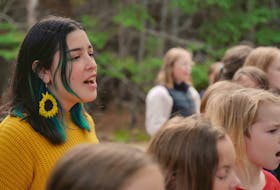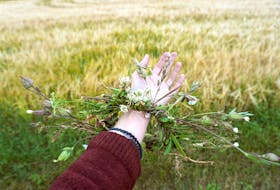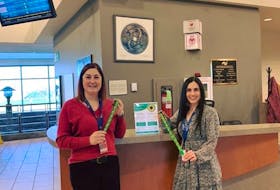MONTRÉAL, Que. — For Tracey Deer, there is before and after the Oka Crisis.
The Mohawk filmmaker was 12 years old in 1990, when the land dispute erupted around the court decision to allow an expansion of Club de golf Oka’s course by nine holes, infringing on Mohawk territory.
Barricades were erected, the police then the army were brought in, and the ensuing summer-long standoff made international headlines.
The conflict became a turning point for Indigenous rights in this country. But against that loaded political backdrop was the story of a little girl, a story Deer has waited 29 years to tell.
The writer-director, who has a background in documentary and is the creator of the TV show Mohawk Girls , is currently on location in Kahnawake shooting her first fiction feature, Beans, which recounts the historic confrontation from the eyes of a child.
“Before the Oka crisis, me and my younger sister were kids,” Deer recalled. “We were having a good time, playing in the woods, making mud [pies]. We had our dolls. It was fun, every single day.
“Back then, once the sun came up we were out after breakfast, on our bikes … and back by sunset. We were exploring the forest, having fires, fishing.”
Deer attended a Mohawk immersion school with mostly white students, but her heritage had never been a problem. Until everything changed.
“The Oka Crisis told me I was different, and that was a bad thing,” Deer said. “It completely shattered my innocence, my sense of safety and self-worth. It was a very dramatic awakening to what it means to be Indigenous.”
Underlining the personal nature of the story is the film’s title, which doubles as her lead character’s nickname. Although Beans is a fictionalized account of the Oka Crisis, Deer drew heavily on her own experience.
“Let me be really clear,” she said. “This is not a story about the Oka Crisis. It’s a story about a young Indigenous girl, with the Oka Crisis as backdrop.”
She spent seven years writing the script, attempting to strike a balance between the dramatic events that took place and a more small-scale drama. It wasn’t easy.
“In draft after draft, the Oka Crisis kept taking too much room,” she said. “I felt this need to ensure the audience understood every element (of the crisis). Then I took the time to say, ‘Wait a second’ and dig into my past as a young girl to figure out what pieces of it I felt imperative to share so that I could be — and my people could be — understood better.”
The 30-day shoot involves several large-scale set pieces. On the day the Montreal Gazette visited, Deer was shooting a scene in which Beans and her sister head to the barricades with their mother to bring sandwiches to the Mohawk Warriors, as tensions rise between the men and police.
As Deer spoke of another big scene in which Mohawks were heading across the river in boats, to get food and medicine, it became unclear whether she was describing the shoot, drawing from memory, or both.
“My people would encounter angry mobs at the docks, who didn’t want to let them off or back on their boats,” she said. “That’s a set piece in the film.”
Deer described multiple scenes of “race riots,” including one that marked her to this day.
“Rocks at Whiskey Trench,” she said. “That was when the army took over operations from the Sureté du Québec. Rumour was that the army was planning to attack, so there was a decision that the women, children and elders should flee the community for safety.
“We left in a caravan of 200 cars. We were stopped at the Mercier (Bridge) and searched for hours by the army, who thought we had weapons. During the time we were waiting, at the other end, (Oka) residents gathered. When we were finally allowed off, (the residents) pelted us with stones and chunks of asphalt.”
The experience still haunts her.
“It was the most traumatic moment of my life,” she said. “It informed who I am, both for good and bad. It’s a scene ripped directly from my memories; it was very hard to write.”
The immediate aftermath of the Oka Crisis was particularly rough for Deer. She went through a dark period, questioning the implications of her Indigenous heritage. As a teenager, she contemplated suicide.
“That would be the bad side,” she said. “The good side was figuring out how to harness that traumatic experience and find something positive. It has really guided all my projects to date in regards to my goals to build bridges and help Canadians see us, and understand us, so that something like that never happens again.”
The Oka Crisis was when Deer decided not only that she would become a filmmaker, but that she would one day make a film about what happened, from the point of view of a child.
“It’s something I stated a very long time ago,” she said. “It’s one of the scariest projects I’ve taken on. There was a lot of internal resistance. Luckily I had a very supportive producer, who let me find my way through it.
“There were so many things I wanted to say. I had to figure out how to get that all into a film. It took time, but it’s always been one of my big goals, my dreams. It’s incredible to be here now, finally doing it.”
Deer sees her movie as an opportunity to reframe the Oka Crisis. Still perturbed by what she calls the “very biased” media coverage of the conflict, which projected a negative image of Indigenous people to the world, she sees her first foray into fiction film as an opportunity to tell another side of the story.
In doing so, she hopes non-Indigenous filmgoers might better understand how those events were lived by the people on the other side of the barricades.
“I hope the film, by bringing viewers into one home and community during the uprising, gives them new perspective of what it was like on our end, and why we did what we did,” she said.
“I hope it builds compassion and understanding. I feel like so much context is missing in terms of what it means to be Indigenous in this country. So much of my work is to build that context so that it isn’t so easy to dismiss us and categorize us as ‘other.’ ”
While Deer had obvious personal motives for telling her tale from the perspective of a 12-year-old girl, she also knew that strategically it might be the most non-threatening way to bring outsiders in.
“It’s very easy to connect with a child, because of their innocence,” she said. “And it’s very hard to dismiss a child in pain and distress.”
Deer’s first feature comes at a time when Indigenous cinema is being celebrated and supported more than ever before in Canada. Government funding agencies are devoting more and more resources to Indigenous filmmakers.
As a reflection of those changes, Indigenous films comprised a significant portion of the 26 features in the Canadian lineup at the Toronto International Film Festival, earlier this month.
“When I started my career, 20 years ago, our presence was so minimal,” Deer said. “Alanis Obomsawin was the centre point we were all able to look at and go, ‘She’s doing it, maybe I can, too.’
“To now be in a time where we’re a community, and we’re all doing it, where there’s space for us and people want to hear from us? It’s very inspiring.”
Beans is expected in theatres in fall 2020.
Copyright Postmedia Network Inc., 2019








